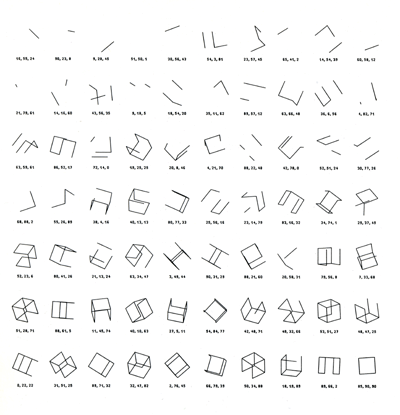 In Cubic Limit, Manfred Mohr introduced the cube into his work as a “fixed system with which signs are generated. In the first part of this work phase (1972-76), an alphabet of signs is created from the twelve lines of a cube. In some works, statistics and rotation are used in the algorithm to generate signs. In others, combinatorial, logical and additive operators generate the global and local structures of the images.”
In Cubic Limit, Manfred Mohr introduced the cube into his work as a “fixed system with which signs are generated. In the first part of this work phase (1972-76), an alphabet of signs is created from the twelve lines of a cube. In some works, statistics and rotation are used in the algorithm to generate signs. In others, combinatorial, logical and additive operators generate the global and local structures of the images.”
“The above programs developed from an earlier program “Sphereless”, P128 (1972) where I generated signs from a less complex fixed structure, the square, using it’s 4 sides and it’s 2 diagonals as the alphabet.”[1]
Image on right is 60 x 60 cm, ink on paper.
The computer became a physical and intellectual extension in the process of creating my art. I write computer algorithms i.e. rules that calculate and then generate the work which could not be realized in any other way. My artistic goal is reached when a finished work can dissociate itself from its logical content and stand convincingly as an independent abstract entity.
Mohr’s systemic exploration of the formal geometries parallels work by artists associated with minimalism and conceptual art, in particular Sol Lewitt’s Variations of Incomplete Open Cubes, 1974 (right and linked entry on site). Whereas Lewitt’s analog work stipulated the condition that the variations must be able to exist as three-dimensional forms Mohr’s digital investigations include all conceivable possibilities, exhaustively explored and plotted by a computer.
Such approaches to art have been reconsidered by contemporary artists employing digital media, including Casey Reas in his {Software} Structures project and John Simon Jr. in Every Icon.
[1] Manfred Mohr, artist’s website: http://www.emohr.com/two_1972.html
